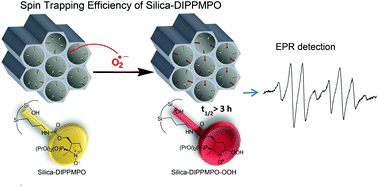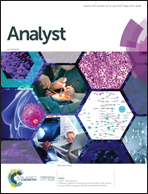Embedding cyclic nitrone in mesoporous silica particles for EPR spin trapping of superoxide and other radicals†
Abstract
The generation of superoxide radical anion in biological systems is one of the major initiating events in the redox biology of NADPH oxidases and mitochondrial redox signalling. However, the pallette of chemical tools for superoxide detection is very limited, hampering progress in understanding the chemical biology of superoxide. Although EPR spin trapping is regarded as the most rigorous technique for superoxide detection, rapid reduction of the EPR-active superoxide spin adducts to EPR-silent hydroxylamines, or to hydroxyl radical adducts by bioreductants, significantly limits the applicability of this technique in biological systems. To overcome these limitations, in this work, we report the synthesis and characterization of a new mesoporous silica functionalized with a phosphorylated cyclic spin trap (DIPPMPO nitrone). The DIPPMPO-grafted silica is a versatile spin-trap agent enabling the identification of a wide range of carbon or oxygen-centered transient radicals in organic and in aqueous media. Moreover, superoxide was efficiently trapped under in vitro conditions in both cell-free and cellular systems. The generated superoxide adduct exhibited an exceptional half-life of 3.5 h and a resistance toward bioreductant agents such as glutathione for several hours.

- This article is part of the themed collection: Analyst Recent HOT articles


 Please wait while we load your content...
Please wait while we load your content...